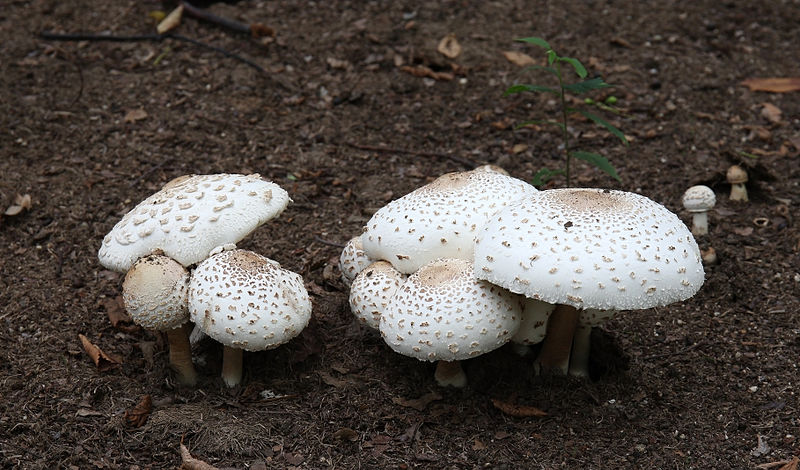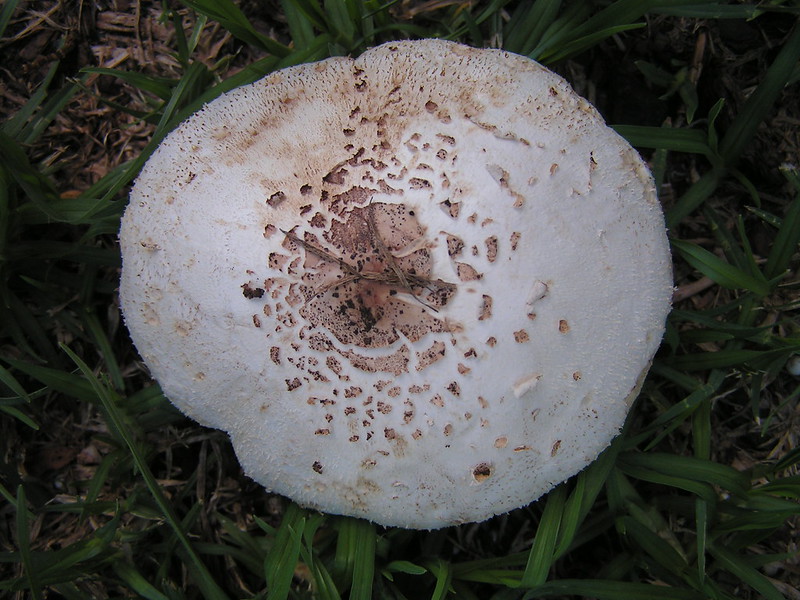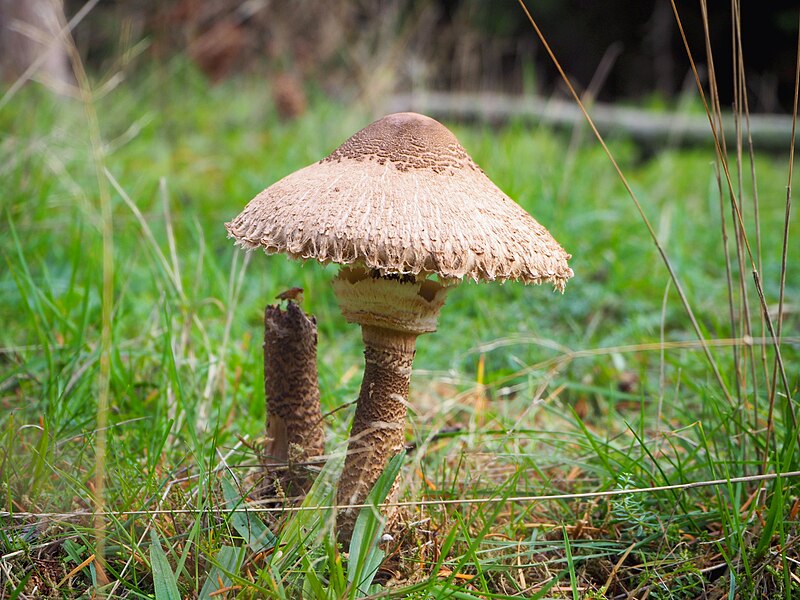The false parasol mushroom presents one of the most challenging identification puzzles for both novice and experienced foragers. While its distinctive brownish scales and impressive size might tempt casual observers to classify it as an edible species, this deceptive fungus harbors dangerous toxins that can cause severe illness. As urban gardens and cultivated areas become increasingly common habitats for these mushrooms, understanding their key identifying features and potentially deadly lookalikes has never been more critical. The line between safe consumption and serious poisoning often comes down to subtle details that demand careful examination and expertise.
Key Takeaways
- Cap starts oval/egg-shaped, flattens with age, and displays brownish scales on white background, measuring 4-10 inches in diameter.
- Gills begin white but turn distinctly green as spores mature, producing green spore prints unlike edible lookalikes.
- Sturdy stem reaches 4-10 inches tall with 0.4-1.0 inches thickness, featuring a movable ring.
- Commonly found in urban/suburban areas, especially lawns and gardens, growing in clusters during warm, wet periods.
- Never consume without absolute certainty, as misidentification can cause severe poisoning symptoms within 2-6 hours of ingestion.

Physical Characteristics and Features
Although often mistaken for edible parasol mushrooms, the false parasol (Chlorophyllum molybdites) exhibits distinct physical features that aid in its identification. This large mushroom typically reaches heights of 5-10 inches, with caps spanning 4-10 inches in diameter when fully mature.
The cap begins as oval or egg-shaped before expanding into a flattened parasol form, displaying distinctive brownish scales arranged in a concentric pattern on a white background. As the mushroom matures, these scales often become more scattered and patchy across the cap’s surface.
The gills underneath the cap present a vital identifying feature, starting white but turning distinctively green as the spores mature. The sturdy stem measures 4-10 inches tall and 0.4-1.0 inches thick, featuring a prominent, movable ring near the top.
The stem base exhibits a noticeable bulb, while the flesh appears white throughout but may slowly stain reddish-brown when cut or bruised. When creating a spore print, the false parasol produces characteristic green spores, distinguishing it from similar-looking edible species that produce white spores.

Common Habitat and Growth Patterns
The false parasol mushroom thrives in urban and suburban environments across North America, particularly in lawns, gardens, parks, and disturbed areas. These mushrooms frequently appear in clusters or rings during warm, wet periods from late spring through fall, especially after heavy rains. They show a marked preference for mulched areas and locations with decomposing woody material.
Growth patterns typically involve extensive underground mycelial networks that can spread several meters in diameter. The mushrooms emerge in successive flushes throughout the growing season, often reappearing in the same locations year after year. Individual specimens can reach maturity within 4-7 days of first emerging from the soil.
These fungi demonstrate remarkable adaptability to various soil conditions but show preference for slightly acidic to neutral pH levels. They commonly establish themselves near deciduous trees, especially oaks and maples, where they can access abundant organic matter. In urban settings, false parasols frequently colonize areas with wood chip mulch, composted materials, or degrading tree stumps, creating persistent populations that can survive for many years in suitable locations.
Dangerous Lookalike Species
Distinguishing false parasol mushrooms from their deadly lookalikes requires careful attention to detail, as several dangerous species share similar characteristics. The most notorious lookalike is the deadly Amanita phalloides, commonly known as the death cap mushroom, which has caused numerous fatal poisonings worldwide.
The death cap’s similar size, coloring, and parasol-like shape make it particularly dangerous for inexperienced foragers. Key differences include the death cap’s distinctive volva, or cup-like base, and its white gills that remain white even at maturity, unlike the false parasol’s brown-aging gills.
Another hazardous lookalike is the destroying angel (Amanita bisporigera), which displays pure white coloring and similar stature to young false parasols. This species contains deadly amatoxins that can cause liver failure within days of consumption.
The green-spored parasol (Chlorophyllum molybdites) presents a less lethal but still serious risk, causing severe gastrointestinal distress. It can be identified by its distinctive green spore print and tendency to stain reddish-brown when cut or bruised, features that help distinguish it from edible parasol varieties.

Symptoms of False Parasol Poisoning
Recognizing false parasol mushroom poisoning begins with understanding its characteristic symptoms, which typically emerge within 2-6 hours after consumption. The initial signs often appear as severe gastrointestinal distress, followed by a progression of increasingly serious symptoms that may require immediate medical intervention.
| Timeline | Primary Symptoms | Severity Level |
|---|---|---|
| 2-6 hours | Nausea, vomiting | Moderate |
| 6-12 hours | Abdominal pain, diarrhea | Severe |
| 12-24 hours | Dehydration, weakness | Critical |
| 24-48 hours | Liver dysfunction | Life-threatening |
| 48+ hours | Organ failure risk | Emergency |
Victims typically experience intense abdominal cramping accompanied by profuse sweating and excessive salivation. These symptoms can persist for several days, with severity varying based on the amount consumed and individual sensitivity.
The final phase of poisoning may include reduced urinary output and jaundice, indicating potential liver damage. Recovery usually occurs within 5-7 days with proper medical treatment, though some individuals may experience lingering effects for several weeks, particularly related to liver function.
Seasonal Distribution and Range
The false parasol mushroom’s seasonal distribution extends primarily through late summer and autumn months in temperate regions. These potentially dangerous fungi emerge most abundantly after periods of rainfall when soil temperatures remain consistently warm, typically between 60-70°F (15-21°C).
The geographical range of false parasol mushrooms spans multiple continents, with notable concentrations in North America, Europe, and parts of Asia. Their habitat preferences include disturbed soils, urban areas, and the edges of wooded regions where organic matter accumulates.
Key seasonal patterns include:
- Peak fruiting occurs from August through October in most Northern Hemisphere locations
- Southern regions may see specimens appearing as early as July and persisting into November
- Winter fruiting can occur in Mediterranean climates during mild, wet conditions
Understanding these distribution patterns helps foragers avoid peak seasons when false parasols are most likely to be confused with edible species. The mushrooms often appear in clusters or fairy rings, particularly in areas with decomposing wood chips, mulch, or buried tree roots.



